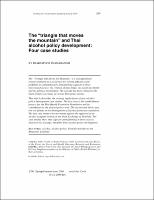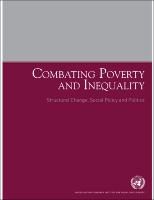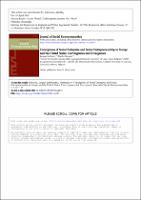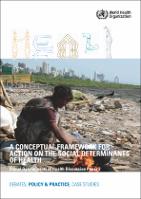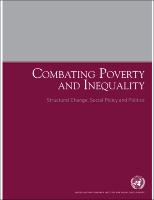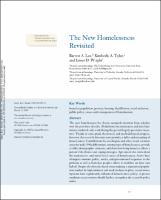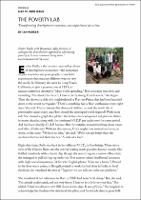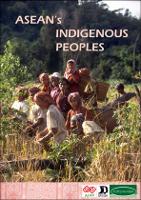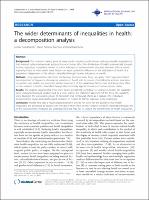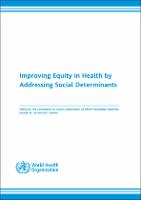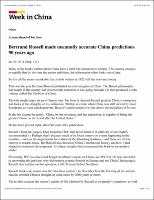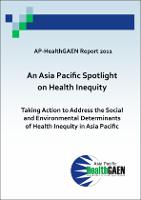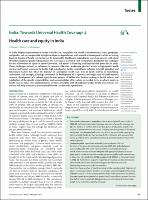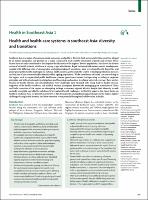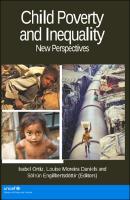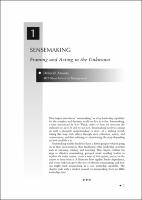Browsing by Issue Date
Now showing items 41-60 of 229
-
The “Triangle That Moves the Mountain” and Thai Alcohol Policy Development: Four Case Studies
(Contemporary Drug Problems, 2009)
The “Triangle that Moves the Mountain” is a conceptualized strategy initiated as a social tool for solving difficult social problems, by simultaneously strengthening capacity in three interrelated sectors: (1) creation of knowledge; (2) social movement; and (3) political involvement. The concept has been claimed as the basis of many successes in various Thai policy arenas. This article describes the strategy implications of four alcohol policy development case studies. The first case is the establishment process for the Thai Health Promotion ... -
Combating poverty and inequality: structural change, social policy and politics
(United Nations Research Institute for Social Development, 2010)
Poverty reduction is a central feature of the international development agenda and contemporary poverty reduction strategies increasingly focus on “targeting the poor”, yet poverty and inequality remain intractable foes. Combating Poverty and Inequality argues that this is because many current approaches to reducing poverty and inequality fail to consider key institutional, policy and political dimensions that may be both causes of poverty and inequality, and obstacles to their reduction. Moreover, when a substantial proportion of a country’s ... -
Conceptions of Social Enterprise and Social Entrepreneurship in Europe and the United States: Convergences and Divergences
(Journal of Social Entrepreneurship, 2010)
The concepts of social enterprise and social entrepreneurship are making amazing breakthroughs in EU countries and the United States. Until recently, the debates on both sides of the Atlantic have taken place in parallel trajectories with few connections among them. In the first part of the paper, we describe the European and US historical landscapes in which those concepts took root. In the second part, we analyse how the various conceptualizations have evolved. This analysis paves the way for the third part, in which we highlight the conceptual ... -
Regional strategy on health system strengthening and primary health care
(Manila : WHO Regional Office for the Western Pacific, 2010) -
Regional strategy on health system strengthening and primary health care
(WHO Regional Office for the Western Pacific, 2010) -
A conceptual framework for action on the social determinants of health
(World Health Organization, 2010)
Complexity defines health. Now, more than ever, in the age of globalization, is this so. The Commission on Social Determinants of Health (CSDH) was set up by the World Health Organization (WHO) to get to the heart of this complexity. They were tasked with summarizing the evidence on how the structure of societies, through myriad social interactions, norms and institutions, are affecting population health, and what governments and public health can do about it. To guide the Commission in its mammoth task, the WHO Secretariat conducted a review ... -
Combating poverty and inequality: structural change, social policy and politics
(United Nations Research Institute for Social Development, 2010)
Poverty reduction is a central feature of the international development agenda and contemporary poverty reduction strategies increasingly focus on “targeting the poor”, yet poverty and inequality remain intractable foes. Combating Poverty and Inequality argues that this is because many current approaches to reducing poverty and inequality fail to consider key institutional, policy and political dimensions that may be both causes of poverty and inequality, and obstacles to their reduction. Moreover, when a substantial proportion of a country’s ... -
Deconstructing development discourse: buzzwords and fuzzwords
(Practical Action Pub. ; Oxfam, 2010)
"Writing from diverse locations, contributors critically examine some of the key terms in current development discourse. Why should language matter to those who are doing development? Surely, there are more urgent things to do than sit around mulling over semantics? But language does matter. Whether emptied of their original meaning, essentially vacuous, or hotly contested, the language of development not only shapes our imagined worlds, but also justifies interventions in real people's lives. If development buzzwords conceal ideological differences ... -
The New Homelessness Revisited
(Annual Review of Sociology, 2010)
The new homelessness has drawn sustained attention from scholars over the past three decades. Definitional inconsistencies and data limitations rendered early work during this period largely speculative in nature. Thanks to conceptual, theoretical, and methodological progress, however, the research literature now provides a fuller understanding of homelessness. Contributions by sociologists and other social scientists since the mid-1990s differentiate among types of homelessness, provide credible demographic estimates, and show how being homeless ... -
ASEAN's Indigenous Peoples
(AIPP,IWGIA,FORUM-ASIA, 2010)
Indigenous Peoples are not at all mentioned or referred to in any ASEAN document, even though they are an integral part of the ASEAN Community and among its most vulnerable sectors, whose interest the ASEAN has committed itself to protect. The failure of the ASEAN to address the plight of its Indigenous Peoples despite its expressed commitment to human rights and social justice is a shortcoming that needs to be corrected urgently. Unless Indigenous Peoples are fully recognized as integral part of a culturally diverse ASEAN, and unless Indigenous ... -
The wider determinants of inequalities in health: a decomposition analysis
(International Journal for Equity in Health, 2011)
Background: The common starting point of many studies scrutinizing the factors underlying health inequalities is that material, cultural-behavioural, and psycho-social factors affect the distribution of health systematically through income, education, occupation, wealth or similar indicators of socioeconomic structure. However, little is known regarding if and to what extent these factors can assert systematic influence on the distribution of health of a population independent of the effects channelled through income, education, or wealth. Methods: ... -
Improving equity in health by addressing social determinants
(World Health Organization, 2011)
This recently published book highlights actions to improve health equity based on findings from the nine global Knowledge Networks that were established during the WHO Commission on Social Determinants of Health. Their task was to synthesize existing evidence and identify effective and appropriate actions to improve health equity in nine thematic areas: - globalization; - gender; - social exclusion; - early child development; - urban settings; - employment conditions; - health systems; - public health programs; and - measurement and evidence. ... -
A man ahead of his time: Bertrand Russell made uncannily accurate China predictions 90 years ago
(Week in China, 2011) -
An Asia Pacific Spotlight on Health Inequity: Taking Action to Address the Social and Environmental Determinants of Health Equity in Asia Pacific
(2011)
In the full report we describe the extent of health inequities between and within countries across the Asia Pacific region. We explore the plausible causal relationships between social and environmental factors and health inequities and describe actions that are taking place to improve health inequities in Asia Pacific. The report is based on pre-existing data policy-mapping case studies and expert knowledge from across the region. We have drawn upon reports and peer-reviewed publications from a diversity of disciplines such as public health ... -
Health care and equity in India
(The Lancet, 2011)
In India, despite improvements in access to health care, inequalities are related to socioeconomic status, geography, and gender, and are compounded by high out-of-pocket expenditures, with more than three-quarters of the increasing financial burden of health care being met by households. Health-care expenditures exacerbate poverty, with about 39 million additional people falling into poverty every year as a result of such expenditures. We identify key challenges for the achievement of equity in service provision, and equity in financing and ... -
Health and health-care systems in southeast Asia: diversity and transitions
(The Lancet, 2011-01-25)
Southeast Asia is a region of enormous social, economic, and political diversity, both across and within countries, shaped by its history, geography, and position as a major crossroad of trade and the movement of goods and services. These factors have not only contributed to the disparate health status of the region's diverse populations, but also to the diverse nature of its health systems, which are at varying stages of evolution. Rapid but inequitable socioeconomic development, coupled with differing rates of demographic and epidemiological ... -
The Social Determinants of Health: Coming of Age
(Annual Review of Public Health, 2011-04-21)
In the United States, awareness is increasing that medical care alone cannot adequately improve health overall or reduce health disparities without also addressing where and how people live. A critical mass of relevant knowledge has accumulated, documenting associations, exploring pathways and biological mechanisms, and providing a previously unavailable scientific foundation for appreciating the role of social factors in health. We review current knowledge about health effects of social (including economic) factors, knowledge gaps, and research ... -
Child Poverty and Inequality: New Perspectives
(2012)
The 21st century starts with vast inequalities for children in terms of income, access to food, water, health, education, housing, or employment for their families. Half of the world’s children are below the poverty line of $2 a day and suffer from multiple deprivations and violations to basic human rights. More than 22,000 children die each day, and most of their deaths are preventable. This volume presents some of the critical acknowledged voices to move a necessary agenda forward. It explains multidimensional poverty measurements, describes ... -
Sensemaking: framing and acting in the unknown
(2012)
This chapter introduces “sensemaking” as a key leadership capability for the complex and dynamic world we live in today. Sensemaking, a term introduced by Karl Weick, refers to how we structure the unknown so as to be able to act in it. Sensemaking involves coming up with a plausible understanding—a map—of a shifting world; testing this map with others through data collection, action, and conversation; and then refining, or abandoning, the map depending on how credible it is. Sensemaking enables leaders to have a better grasp of what is going ...

